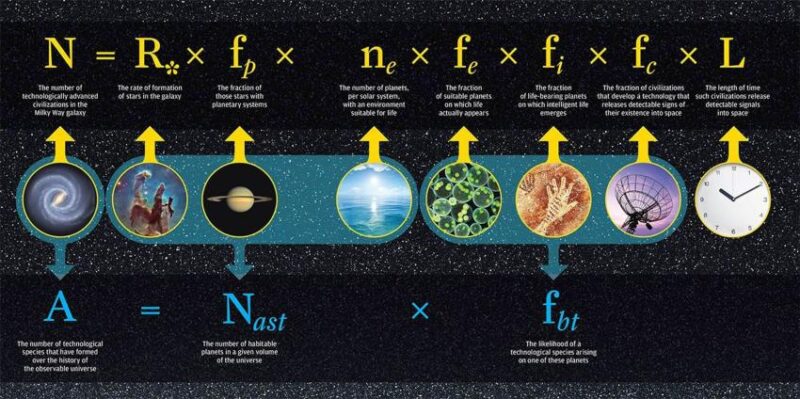- Intelligent life in the universe requires the existence of stars and worlds around stars, as far as we know.
- Stars form from clumps of matter, and this structure is possible thanks to a universe where dark energy makes the universe expand faster to balance gravity’s inward pull.
- Of all possible universes, a new study found that our universe might not even be the best possible universe for forming life.
The Royal Astronomical Society published this original story at 00:01 GMT on November 13, 2024. Edits by EarthSky.
Estimating the chances for intelligent life
The chances of intelligent life emerging in our universe – and in any hypothetical ones beyond it – is something astronomers have now estimated, using a new theoretical model with echoes of the famous Drake Equation. This was the formula that American astronomer Frank Drake came up with in the 1960s to calculate the number of detectable extraterrestrial civilizations in our Milky Way galaxy.
More than 60 years on, astrophysicists led by Durham University have produced a different model, which instead focuses on the conditions created by the acceleration of the universe’s expansion and the amount of stars formed.
It is thought this expansion is being driven by a mysterious force called dark energy that makes up more than 2/3s of the universe.
The peer-reviewed Monthly Notices of the Royal Astronomical Society published the study on November 13, 2024.
What is the calculation?
Stars are a precondition for the emergence of life as we know it. So the model could therefore be used to estimate the probability of generating intelligent life in our universe, and in a multiverse scenario of hypothetical different universes.
The new research does not attempt to calculate the absolute number of observers (i.e. intelligent life) in the universe. But instead it considers the relative probability of a randomly chosen observer inhabiting a universe with particular properties.
It concludes that a typical observer would expect to experience a substantially larger density of dark energy than we see in our own universe. And that suggests the ingredients our universe possesses make it a rare and unusual case in the multiverse.
The approach presented in the paper involves calculating the fraction of ordinary matter converted into stars over the entire history of the universe, for different dark-energy densities.
The model predicts this fraction would be approximately 27% in a universe that is most efficient at forming stars, compared to 23% in our own universe.
This means we don’t live in the hypothetical universe with the highest odds of forming intelligent lifeforms. Or in other words, the value of dark energy density we observe in our universe is not the one that would maximize the chances of life, according to the model.
Dark energy’s impact on our existence
Lead researcher Daniele Sorini, of Durham University’s Institute for Computational Cosmology, said:
Understanding dark energy and the impact on our universe is one of the biggest challenges in cosmology and fundamental physics.
The parameters that govern our universe, including the density of dark energy, could explain our own existence.
Surprisingly, though, we found that even a significantly higher dark energy density would still be compatible with life, suggesting we may not live in the most likely of universes.
The new model could allow scientists to understand the effects of differing densities of dark energy on the formation of structures in the universe and the conditions for life to develop in the cosmos.
The role of dark energy in intelligent life
Dark energy makes the universe expand faster, balancing gravity’s pull and creating a universe where both expansion and structure formation are possible.
However, for life to develop, there would need to be regions where matter can clump together to form stars and planets, and it would need to remain stable for billions of years to allow life to evolve.
Crucially, the research suggests that the astrophysics of star formation and the evolution of the large-scale structure of the universe combine in a subtle way to determine the optimal value of the dark energy density needed for the generation of intelligent life.
Lucas Lombriser, Université de Genève and co-author of the study, added:
It will be exciting to employ the model to explore the emergence of life across different universes and see whether some fundamental questions we ask ourselves about our own universe must be reinterpreted.

Drake Equation explained
Drake’s equation was more of a guide for scientists on how to go about searching for life, rather than an estimating tool or serious attempt to determine an accurate result.
Its parameters included the rate of yearly star formation in the Milky Way, the fraction of stars with planets orbiting them and the number of worlds that could potentially support life.
By comparison, the new model connects the rate of yearly star formation in the universe with its fundamental ingredients, such as the aforementioned dark energy density.

Bottom line: A team of astronomers recently looked at how different densities of dark matter in various possible universes would affect the chances for intelligent life. They found we might not even live in the best possible universe for forming life.
Source: The impact of the cosmological constant on past and future star formation
Via Royal Astronomical Society